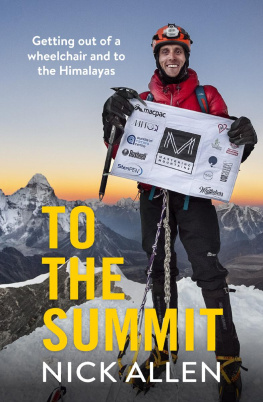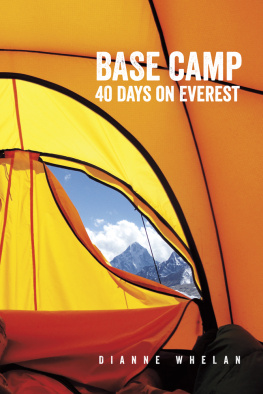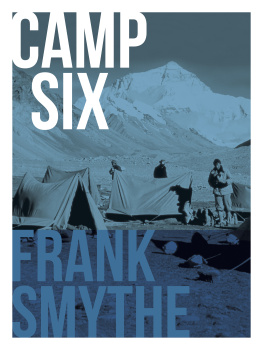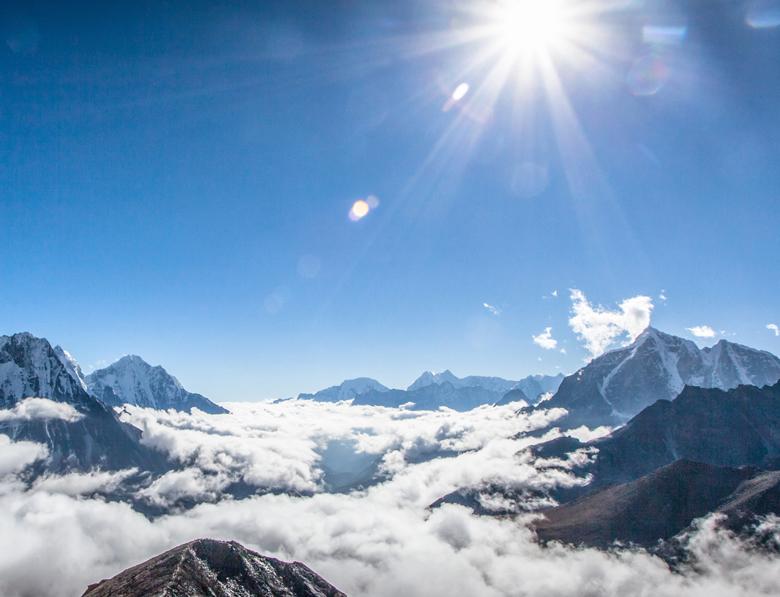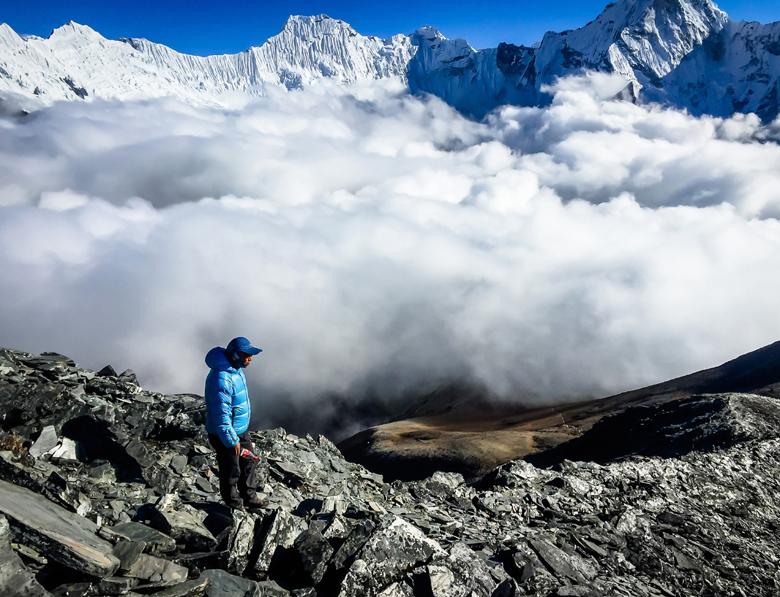Pasang coming down off Chukhung Ri with the cloud coming up from the valley below.
Its too warm, Pasang shouted over the wind. This is very bad bad weather is coming. He unzipped his heavy down jacket.
How far away is the front? I shouted, trying to make myself heard over the noise of the stiff breeze.
Pasang looked down at the clouds building in the valleys several hundred metres below us. The occasional threatening wisp was cast up towards the barren rock-and-snow summits we stood beneath.
When the warm winds blow, the storm is coming, Pasang yelled. About one and a half or two days away. It is coming with snow.
He pointed up to Lhotse (8516 metres) towering above us, seemingly within reaching distance of our position just beneath the summit of Chukhung Ri (5550 metres).
I looked across to the scarred black ridges fringing the thousands of metres of vertical ice and snow that cling to Lhotses south face. At the top, a sharp-edged wing of cloud and ice was streaming off Lhotses peak, crowning more nebulous formations swirling off the eastern ridge. The wind was clearly violent.
Yes, I see it, I said, trying not to be distracted by the enormity of the view.

Thrilled to have reached the top of Chukhung Ri, I grabbed a selfie with Ama Dablam in the background. This was my first time above 5500 metres since my miserable experience on Stok Kangri.
Cloud suddenly enveloped us. My focus snapped back to the terrain directly around me. We were scrambling down ledges and slopes covered in loose shards of schist that glistened in the sun. There was no grass or moss at this altitude, just rock fractured by the endless leveraging of the freezethaw cycle. It was slow going and I needed to take care, but I quickened my pace so I could catch up with Pasang.
Sorry, what was that? I shouted into the wind.
He just kept moving.
When I did manage to catch up, Pasang said, Ice trails on Lhotse are very bad sign. The winds have come and it means stronger winds come. Snow and high winds are not good for climbing we need to reach Base Camp tomorrow, otherwise we miss the weather window.
The news of an approaching front was hardly surprising. For the last few days we had woken to a sky full of high cirrus clouds, a development that marked a change from the more settled weather patterns of the past week. The clouds were beautiful in the mornings, catching the early light and painting the sky with colour, but they were also the harbinger of an approaching front.
Pasang probably knew this better than anyone; a Sherpa by birth, he grew up in these mountains. His family home was in Khumjung, a few kilometres back down the valley, and as a child and young teen he was responsible for the familys yak herd. Every summer, he would bring the herd up these valleys to graze on the mountain pastures. He slept out in the wild with them, sheltering from storms and during cold nights alone. Yes, he knew how to read these mountains.

The need to get to Island Peak Base Camp the next day worried me. It was a day earlier than we had planned, and I was anxious about rushing our progress up the mountain. Tomorrow was supposed to be a rest day, an opportunity to gain the strength needed for the climb ahead. In view of my traumatic failure to summit Stok Kangri in northern India just three weeks earlier, and considering that our schedule afforded me only one shot at Island Peak, I was worried that forfeiting a rest day could jeopardise my chance to summit. But then I wasnt prepared to surrender to the sky either.
How long do you think this weather will last? Do you think we could wait until it has cleared?
I almost slid on the loose rocks as I tried to keep up with Pasang.
Waiting for the weather is bad option, he replied. It could take one week or ten days to clear, and then there will be much snow on Island Peak, making the walking more difficult. I think we climb as soon as possible. We move quickly, to get back to Chukhung and the teahouse. We have lots to do. We need to do a gear check and pack.
I tried to think of alternatives, a different solution. What if we walked over Kongma La tomorrow, headed up to Everest Base Camp, then came back to Island Peak for a climb?
We could do, but another weather window might not come, and we would have no time to do Three Passes trek.
I was excited about completing the famous Three Passes trek crossing Kongma La (5535 metres), Cho La (5420 metres) and Renjo La (5465 metres) and I knew I would be disappointed to give it up, only to sit in a teahouse for days waiting for the weather to clear. And to miss the opportunity to climb Island Peak? Well, that was unthinkable.
I weighed up the options, nervous and uncertain about the best course of action. I felt the burden of my unsuccessful attempt on Stok Kangri. I did not want to lose another peak to do so would mean writing off the whole trip, and my months of training, as a waste of time. I knew I would kick myself if I missed out on both Island Peak and the Three Passes trek because of a decision to postpone the climb. I need to accomplish something, I thought, and climbing sooner rather than later was probably the least risky option.

